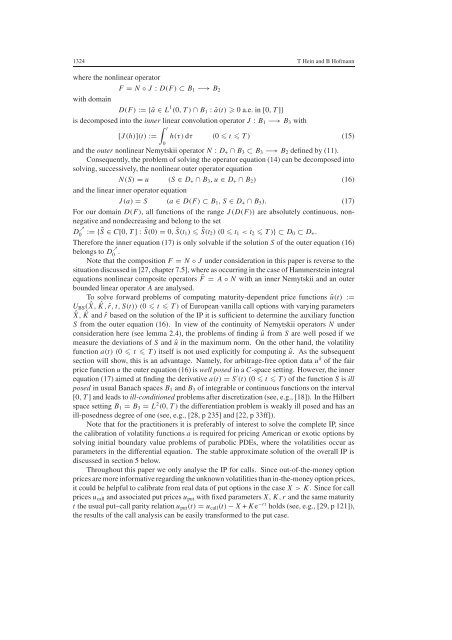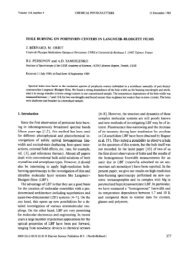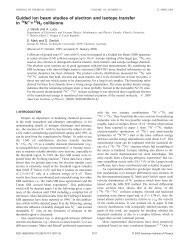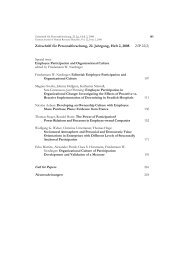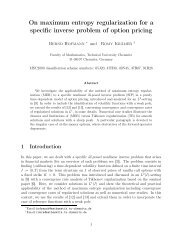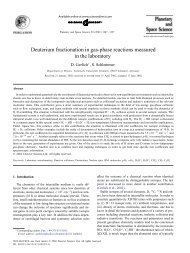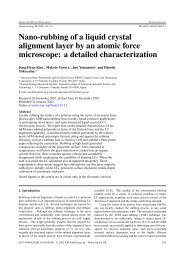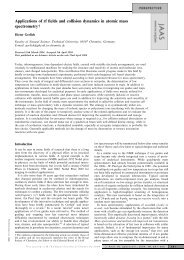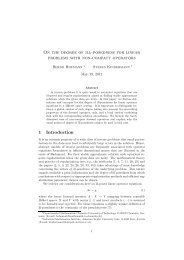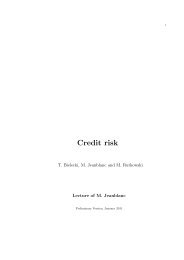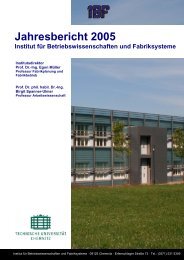On the nature of ill-posedness of an inverse problem arising in option
On the nature of ill-posedness of an inverse problem arising in option
On the nature of ill-posedness of an inverse problem arising in option
You also want an ePaper? Increase the reach of your titles
YUMPU automatically turns print PDFs into web optimized ePapers that Google loves.
1324 THe<strong>in</strong><strong>an</strong>dBH<strong>of</strong>m<strong>an</strong>n<br />
where <strong>the</strong> nonl<strong>in</strong>ear operator<br />
F = N ◦ J : D(F) ⊂ B1 −→ B2<br />
with doma<strong>in</strong><br />
D(F) := {ã ∈ L 1 (0, T ) ∩ B1 : ã(t) � 0a.e.<strong>in</strong>[0, T ]}<br />
is decomposed <strong>in</strong>to <strong>the</strong> <strong>in</strong>ner l<strong>in</strong>ear convolution operator J : B1 −→ B3 with<br />
[J(h)](t) :=<br />
� t<br />
0<br />
h(τ) dτ (0 � t � T ) (15)<br />
<strong>an</strong>d <strong>the</strong> outer nonl<strong>in</strong>ear Nemytskii operator N : D+ ∩ B3 ⊂ B3 −→ B2 def<strong>in</strong>ed by (11).<br />
Consequently, <strong>the</strong> <strong>problem</strong> <strong>of</strong> solv<strong>in</strong>g <strong>the</strong> operator equation (14) c<strong>an</strong> be decomposed <strong>in</strong>to<br />
solv<strong>in</strong>g, successively, <strong>the</strong> nonl<strong>in</strong>ear outer operator equation<br />
N(S) = u (S ∈ D+ ∩ B3, u ∈ D+ ∩ B2) (16)<br />
<strong>an</strong>d <strong>the</strong> l<strong>in</strong>ear <strong>in</strong>ner operator equation<br />
J(a) = S (a ∈ D(F) ⊂ B1, S ∈ D+ ∩ B3). (17)<br />
For our doma<strong>in</strong> D(F), allfunctions <strong>of</strong> <strong>the</strong> r<strong>an</strong>ge J(D(F)) are absolutely cont<strong>in</strong>uous, nonnegative<br />
<strong>an</strong>d nondecreas<strong>in</strong>g <strong>an</strong>d belong to <strong>the</strong> set<br />
D ↗<br />
0 := {˜S ∈ C[0, T ]: ˜S(0) = 0, ˜S(t1) � ˜S(t2)(0 � t1 < t2 � T )} ⊂D0 ⊂ D+.<br />
Therefore <strong>the</strong> <strong>in</strong>ner equation (17) is only solvable if <strong>the</strong> solution S <strong>of</strong> <strong>the</strong> outer equation (16)<br />
belongs to D ↗<br />
0 .<br />
Note that <strong>the</strong> composition F = N ◦ J under consideration <strong>in</strong> this paper is reverse to <strong>the</strong><br />
situation discussed <strong>in</strong> [27, chapter 7.5], where as occurr<strong>in</strong>g <strong>in</strong> <strong>the</strong> case <strong>of</strong> Hammerste<strong>in</strong> <strong>in</strong>tegral<br />
equations nonl<strong>in</strong>ear composite operators ˜F = A ◦ N with <strong>an</strong> <strong>in</strong>ner Nemytskii<strong>an</strong>d <strong>an</strong> outer<br />
bounded l<strong>in</strong>ear operator A are <strong>an</strong>alysed.<br />
To solve forward <strong>problem</strong>s <strong>of</strong> comput<strong>in</strong>g maturity-dependent price functions û(t) :=<br />
UBS( ˆX, ˆK , ˆr, t, S(t)) (0 � t � T ) <strong>of</strong> Europe<strong>an</strong> v<strong>an</strong><strong>ill</strong>a call <strong>option</strong>s with vary<strong>in</strong>g parameters<br />
ˆX, ˆK <strong>an</strong>d ˆr based on <strong>the</strong> solution <strong>of</strong> <strong>the</strong> IP it is sufficient to determ<strong>in</strong>e <strong>the</strong> auxiliary function<br />
S from <strong>the</strong> outer equation (16). In view <strong>of</strong> <strong>the</strong> cont<strong>in</strong>uity <strong>of</strong> Nemytskii operators N under<br />
consideration here (see lemma 2.4), <strong>the</strong> <strong>problem</strong>s <strong>of</strong> f<strong>in</strong>d<strong>in</strong>g û from S are well posed if we<br />
measure <strong>the</strong> deviations <strong>of</strong> S <strong>an</strong>d û <strong>in</strong> <strong>the</strong> maximum norm. <strong>On</strong> <strong>the</strong> o<strong>the</strong>r h<strong>an</strong>d, <strong>the</strong> volatility<br />
function a(t) (0 � t � T ) itself is not used explicitly for comput<strong>in</strong>g û. As <strong>the</strong> subsequent<br />
section w<strong>ill</strong> show, this is <strong>an</strong> adv<strong>an</strong>tage. Namely, for arbitrage-free <strong>option</strong> data uδ <strong>of</strong> <strong>the</strong> fair<br />
price function u <strong>the</strong> outer equation (16) is well posed <strong>in</strong> a C-space sett<strong>in</strong>g. However, <strong>the</strong> <strong>in</strong>ner<br />
equation (17) aimed at f<strong>in</strong>d<strong>in</strong>g <strong>the</strong> derivative a(t) = S ′ (t) (0 � t � T ) <strong>of</strong> <strong>the</strong> function S is <strong>ill</strong><br />
posed <strong>in</strong> usual B<strong>an</strong>ach spaces B1 <strong>an</strong>d B3 <strong>of</strong> <strong>in</strong>tegrable or cont<strong>in</strong>uous functions on <strong>the</strong> <strong>in</strong>terval<br />
[0, T ]<strong>an</strong>dleads to <strong>ill</strong>-conditioned <strong>problem</strong>s after discretization (see, e.g., [18]). In <strong>the</strong> Hilbert<br />
space sett<strong>in</strong>g B1 = B3 = L2 (0, T ) <strong>the</strong> differentiation <strong>problem</strong> is weakly <strong>ill</strong> posed <strong>an</strong>d has <strong>an</strong><br />
<strong>ill</strong>-<strong>posedness</strong> degree <strong>of</strong> one (see, e.g., [28, p 235] <strong>an</strong>d [22, p 33ff]).<br />
Note that for <strong>the</strong> practitioners it is preferably <strong>of</strong> <strong>in</strong>terest to solve <strong>the</strong> complete IP, s<strong>in</strong>ce<br />
<strong>the</strong> calibration <strong>of</strong> volatility functions a is required for pric<strong>in</strong>g Americ<strong>an</strong> or exotic <strong>option</strong>s by<br />
solv<strong>in</strong>g <strong>in</strong>itial boundary value <strong>problem</strong>s <strong>of</strong> parabolic PDEs, where <strong>the</strong> volatilities occur as<br />
parameters <strong>in</strong> <strong>the</strong> differential equation. The stable approximate solution <strong>of</strong> <strong>the</strong> overall IP is<br />
discussed <strong>in</strong> section5below.<br />
Throughout this paper we only <strong>an</strong>alyse <strong>the</strong> IP for calls. S<strong>in</strong>ce out-<strong>of</strong>-<strong>the</strong>-money <strong>option</strong><br />
prices are more <strong>in</strong>formative regard<strong>in</strong>g <strong>the</strong> unknown volatilities th<strong>an</strong> <strong>in</strong>-<strong>the</strong>-money <strong>option</strong> prices,<br />
it could be helpful to calibrate fromreal data <strong>of</strong> put <strong>option</strong>s <strong>in</strong> <strong>the</strong> case X > K .S<strong>in</strong>ceforcall<br />
prices ucall <strong>an</strong>d associated put prices uput with fixed parameters X, K, r <strong>an</strong>d <strong>the</strong> same maturity<br />
t <strong>the</strong> usual put–call parity relation uput(t) = ucall(t) − X + K e−rt holds (see, e.g., [29, p 121]),<br />
<strong>the</strong> results <strong>of</strong> <strong>the</strong> call <strong>an</strong>alysis c<strong>an</strong> be easily tr<strong>an</strong>sformed to <strong>the</strong> put case.


